This article that I wrote is the full written story of the forced landing in the Lake Buccaneer and it tells the story from Episode #1 and Episode #2 of TomAir. Air Facts published the article HERE and I am told that it will also be published soon in the Canadian Owners and Pilot’s Association (COPA) magazine too. There is a lot of great information on forced landings, survival and making the best of a hairy situation. Enjoy the article!
If anyone out there wants to publish this article please contact me and I will be happy to grant the appropriate permission. I just want to get the story and information out to as many people as possible.
—
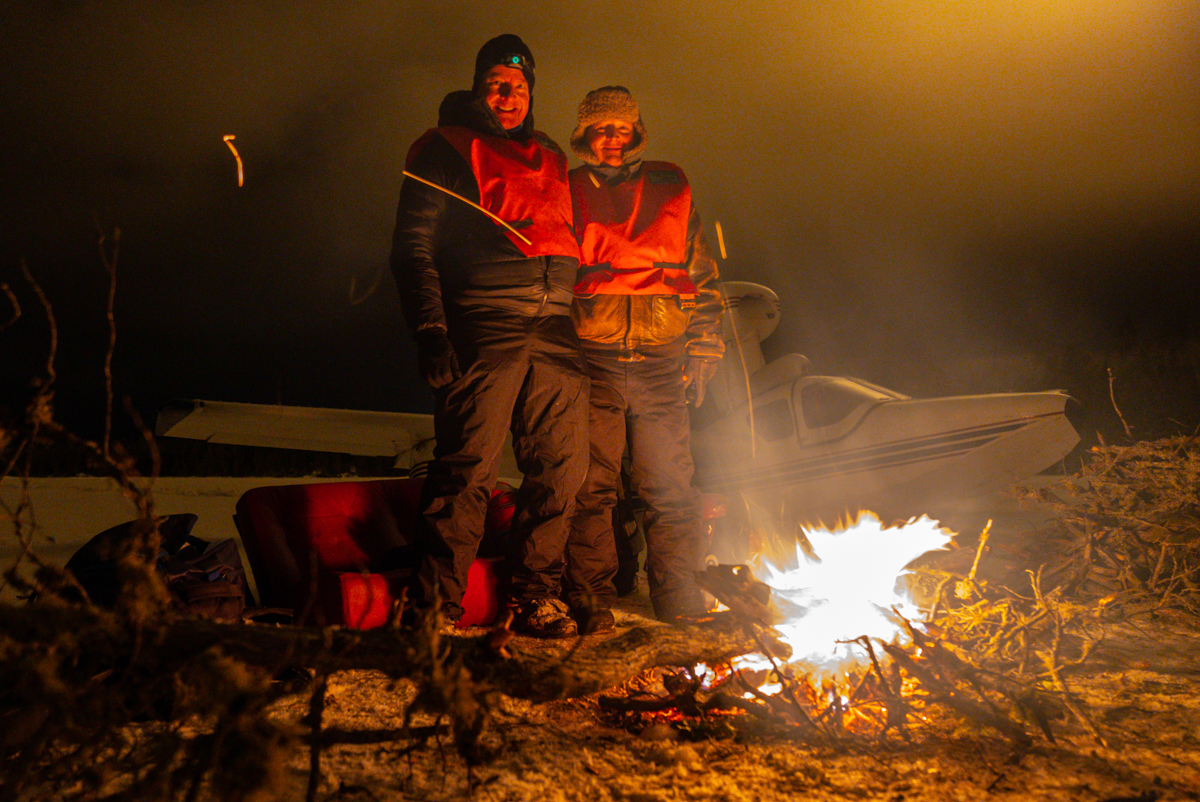
I am fortunate to participate in a lot of aviation adventures, many of which are a result of becoming friends with Paul Briggs, a former Canadian Forces pilot with many thousands of logbook hours in a broad range of aircraft. When Paul called me back in February of 2023 and asked if I wanted to join him in ferrying a couple of Lake Buccaneer aircraft across Canada and back again, I jumped at the opportunity. I loaded up a bunch of cameras, suitable clothing and survival gear and off we went. Little did I know that this trip would turn out to be a much bigger adventure than either of us could have imagined.
The initial westward chapter of our mission had us deliver one Lake Buccaneer from Ontario to its new owner in Calgary Alberta. We then exchanged it for the owner’s original Buccaneer, an LA-4-200, to be ferried back to Muskoka, Ontario. The plan was to sell it, as the owner had upgraded to the one we delivered out west.
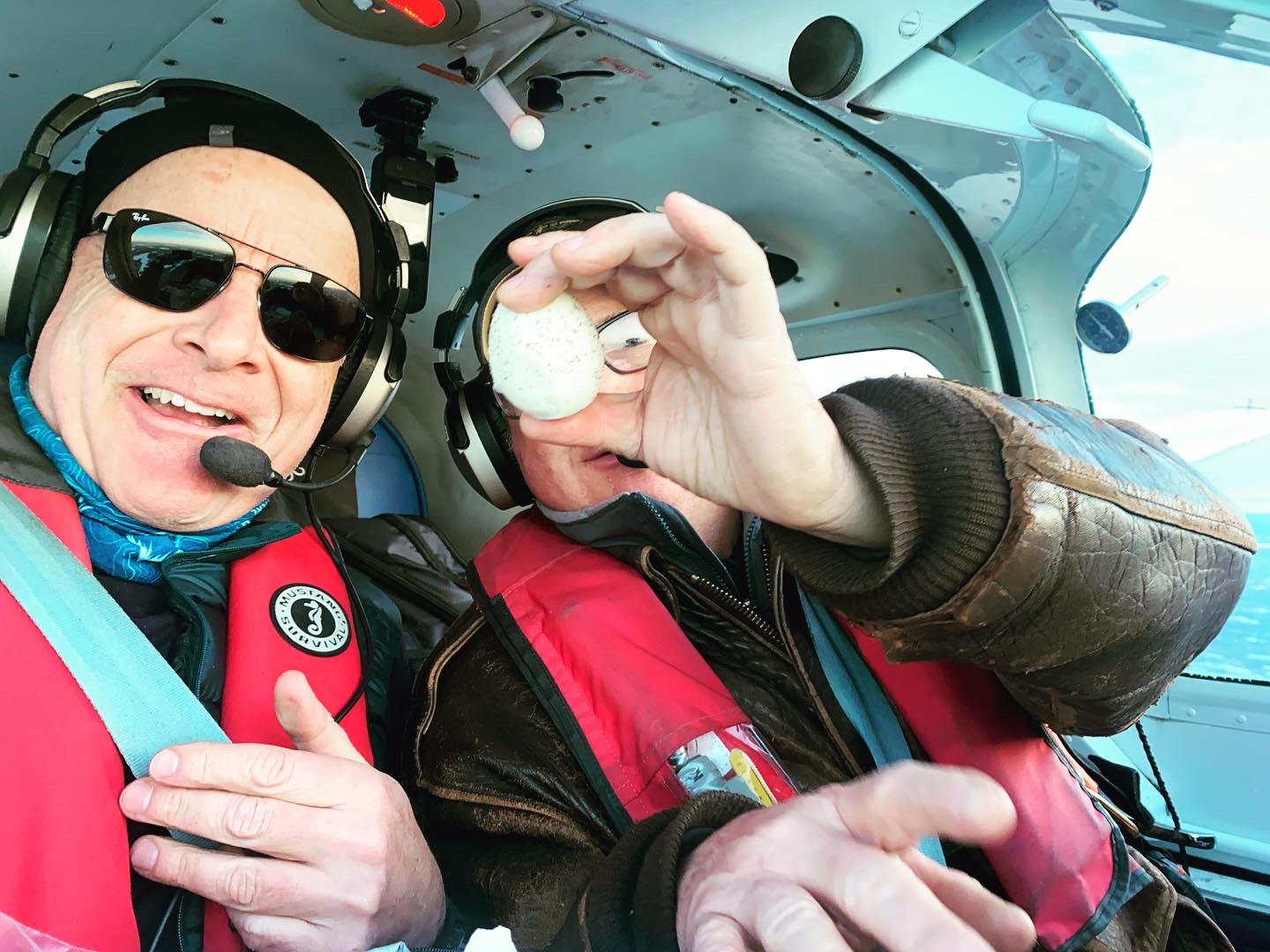
At 5:15pm eastern time on Feb 16, 2023, somewhere between Marathon and Sudbury, Ontario, Paul and I were happily flying along at 7,500’, eagerly anticipating sleeping in our own beds after a week “on the road” as we had followed the Trans-Canada Highway most of the journey for easy navigation. The Lake amphibian is one of Paul’s favorite airplanes but even he admits that they are normally considered fair-weather machines — and this was in the middle of February after all. All was well as we cruised along doing just over 105 knots indicated airspeed just one short hour to the planned end of our 40-plus hour epic flying saga.
With plenty of fuel remaining, we decided to change our routing slightly from direct to Sudbury, to direct to Muskoka in order to push on to the finish line and arrive back at base just after dark — and before forecast lousy weather was to set in. It had been a great journey but we were both looking forward to getting home. Unfortunately there would be no getting home for us on this day, as our real adventure was about to begin.
Very soon after the course change Paul and I both noticed a momentary and ever-so-slight difference in the engine sound. Paul immediately took control of the aircraft and started adjusting the engine settings — mixture, prop, throttle etc. The engine seemed fine but our “spidey senses” were now tingling. If you have flown for a while you learn to pay attention to these things and we were now both on high alert.
Moments later we started experiencing massive vibrations throughout the aircraft and an extremely rough-running engine. It was apparent that we had a full blown emergency on our hands. Paul made the first of two mayday calls as we continued fighting with the rough engine while weighing our diminishing options.
“Mayday, mayday, mayday… C-FFPB is experiencing engine trouble and declaring an emergency….”.
Using Foreflight, I quickly determined that we were 50 miles NW of Sudbury and 40 miles N of Elliot Lake. Paul made the decision to continue to Sudbury due to runway direction and the scale of services available there, but we soon felt that getting to any airport was unlikely. We did receive a confirmation back from London Radio on 123.55 that they heard us, but I don’t remember what they said because just then everything went ominously silent as our IO-360 engine’s heart beat for the last time and we became a glider descending from 7,500′ through a scattered layer of clouds towards the snow-covered, remote and icy ground below.
“Mayday, mayday, mayday. C-FFPB has experienced total engine failure; we are going down… position… two souls onboard…” — to which there was no reply as we were now down below radio reception altitude. This was when things started to get really interesting.
Descending, we could see an ice-covered lake through the scattered cloud deck. Paul pointed our newly minted glider in that direction, being careful to stay at or just above best glide speed. On the way down I turned on our 406 ELT and pressed the big red SOS button on my SPOT satellite transmitter. Both of these devices would work better at altitude than they would on, or possibly in, an icy lake so I figured I’d better use them while we had them.
Paul slipped the aircraft in order to get us down to where he determined was our best position to line up for landing. This was on a section of a frozen lake where it looked like the ice was smoothest. It would also place us in relatively close proximity to the shore, while providing a safe buffer distance between our forced landing site and the rough wooded lakeshore. The ice looked solid enough but it had been a weird winter and we couldn’t tell the thickness for sure from above. How far would we slide or would we just dig in and…? We would find out soon enough.
It took very little time to get down from 7,500’ to lake level at 1,400’ and there was lots to do on the way down. I was on the lookout for roads and any other signs of civilization. There were no snowmobile tracks on the lake and that meant we were definitely remote because there are snowmobiles everywhere in a northern Ontario winter. We tightened our seatbelts, made a couple more unanswered mayday calls and braced for the inevitable.
The next thing I remember, we were in a very gentle flare and then bouncing up and down over the lake’s frozen surface. At first it felt like a slightly firmer than usual landing on an unprepared runway but as we settled more onto the ice the banging began and we started bumping up and down pretty severely.
We skidded along for well over a thousand feet, and there were times when it felt like we might skid sideways and maybe even have a sponson dig in and launch us into a cartwheel. Eventually our stricken machine slowed and settled its tail section into the surface of the lake, coming to rest moored in the ice. Less than four minutes had elapsed since the first sign of trouble to this moment where Paul and I found ourselves in a new and unplanned reality down on the surface of Alton Lake in Ontario’s north. It was 5:20 pm on February 16th, 2023 and was -15°C outside and 35 minutes before sunset with a storm coming in.
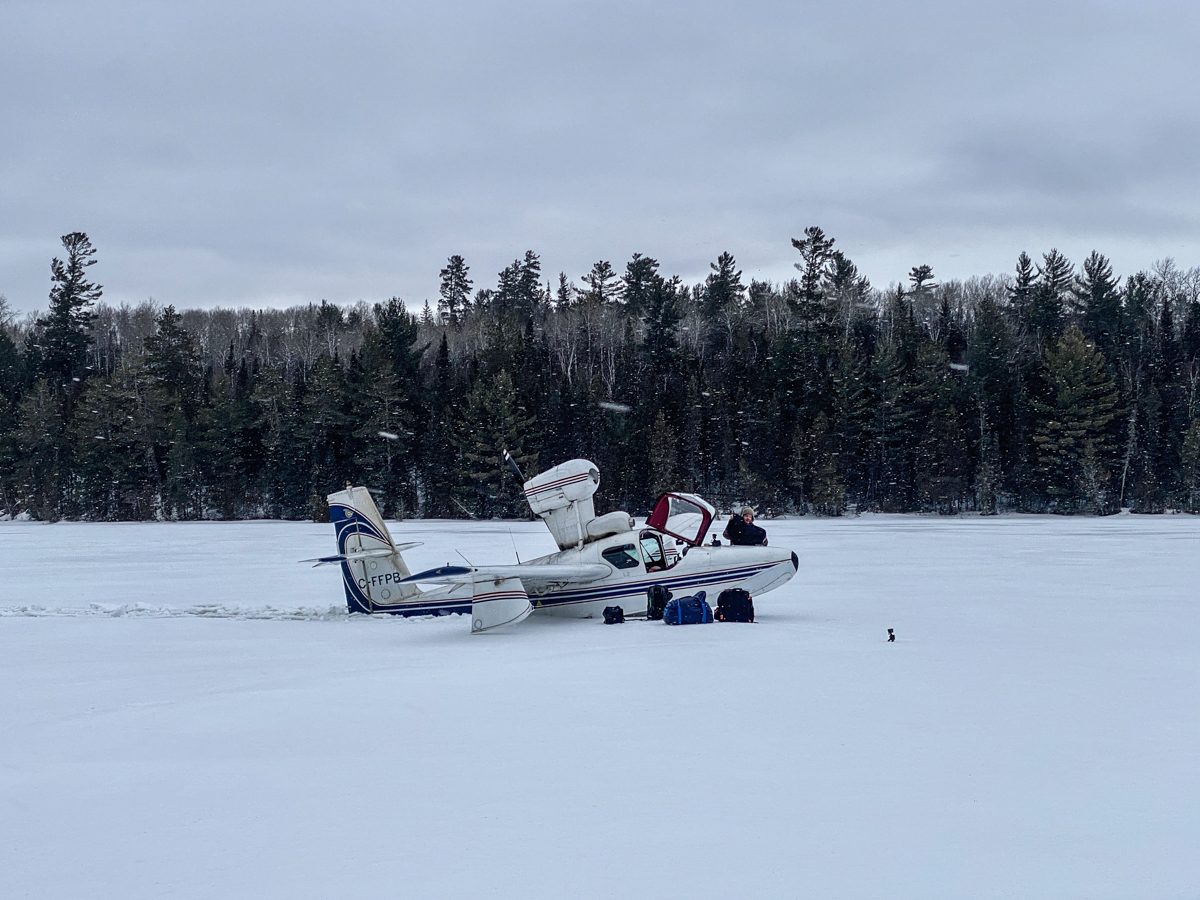
Paul and I were in perfect shape and so was the aircraft — with the exception of the engine which had chosen to destroy itself four minutes earlier. There were no dramatic fuel leaks or fires burning, the cockpit was warm and it was peaceful on the lake with the only sounds being the plane’s gyros spinning down and the rhythmic beeping of our trusty 406 ELT.
Our initial impulse was to jump out and spring into action, but I suggested we first gather our wits, come up with a plan and enjoy the last moments of free heat available to us in the cockpit. We both kept it together and did everything right during the engine failure and subsequent forced landing, but the adrenaline was definitely pumping and this was not the place for hasty decisions that could potentially kill us. It would be a shame to survive a forced landing only to die doing something stupid like falling through thin ice on the lake while making a fire.
We knew survival hinged on us staying warm. To do that we would need to keep our heads together, then bundle up and quickly make a fire. Paul and I are both experienced bush-crafters and we spend a lot of time together in the wilderness, which was a very good thing in a situation like this. It should be obvious that the best time to train for survival is certainly not during a real survival situation. We had done a lot of prior training and our motto is the same as the Boy Scouts: “Always be prepared.” People sometimes ask why we both always have so much gear with us and this is exactly why.
From the start of or our long journey right up to the moment we came to rest on the frozen lake, we had done a lot of things right. For example, Paul had been adamant that we file VFR flight plans with local Flight Information Centres and then, if the local Radio (RCO) could be reached in flight, keep them updated with any real-world changes that had taken place such as precise take-off times and any deviations from our planned track. Here in Canada at VFR cruising altitudes for small normally aspirated aircraft, we are very often not high enough to be on any controller’s radar screen or even within radio reception range, but we did our best to keep the folks at NAV Canada and Flight Services up to date with our progress. This really paid off for us!
While still sitting in the aircraft gathering our thoughts, we decided to broadcast two more distress calls on 121.5. These included our precise GPS location and confirmed that we had landed, wheels-up, on a frozen lake with two occupants who were safe and had survival gear — but please don’t delay sending in the cavalry. We got no reply on the radio but it turns out that an Air Canada flight heard our call and relayed the message onwards, which was what let the outside world know that we were OK.
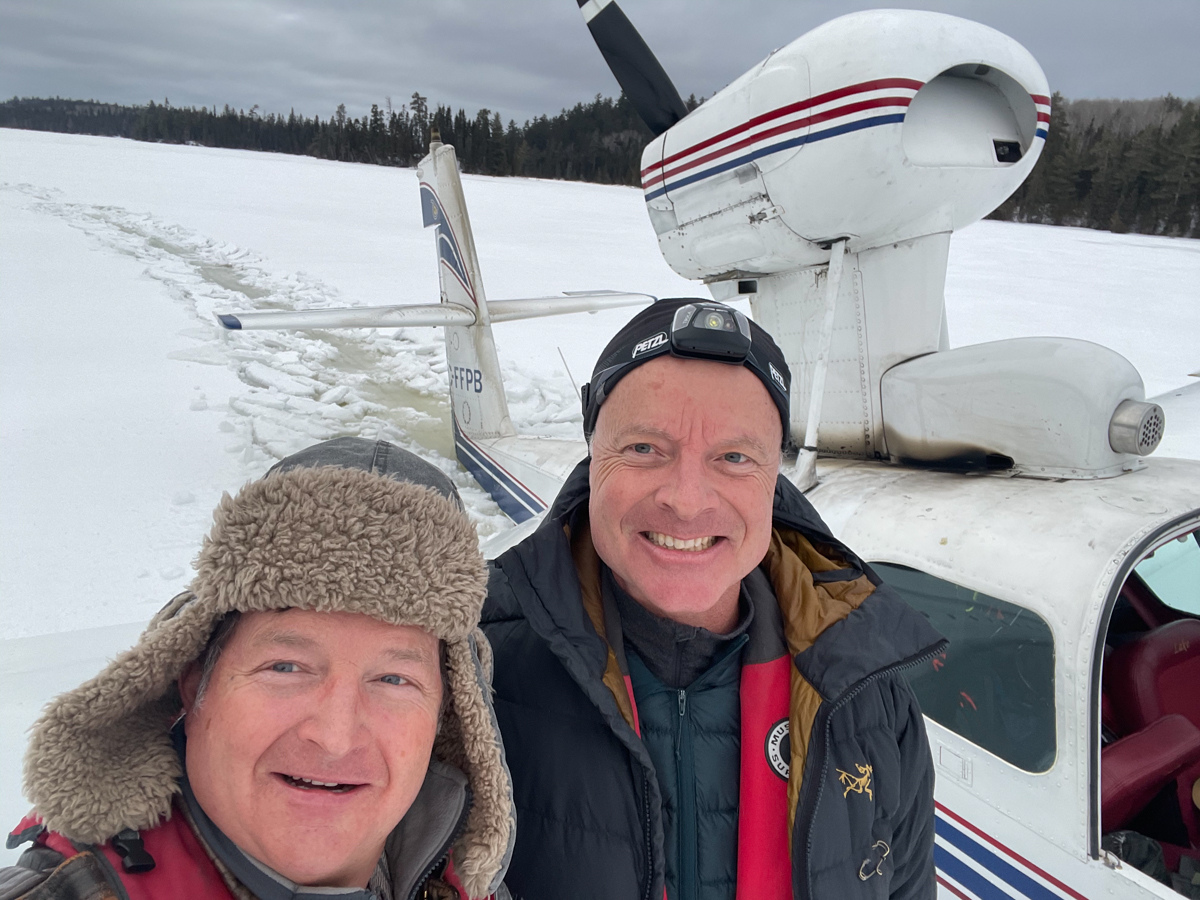
At this point both Paul and I were fairly certain that a search would be underway and that people were probably already figuring out how to get to us. How long the rescue would take was anyone’s guess, as the weather was rapidly deteriorating with ceilings now below 2,000’. It was now almost dark and there are always a lot of factors that can affect the timing of dynamic, remote winter rescues in Canada’s north. However, we had a number of reasons for our positive outlook. These stemmed from all the things we had done correctly up to this stage, including the following:
- We had an accurate flight plan backed up by the mayday call. Our distress call was received and responded to and would have given Flight Services a precise time and, therefore, a relatively precise location along our flight track between Marathon and Sudbury.
- Our 406 ELT appeared to be functioning properly and it provided great comfort chirping away in the background. Being switched on while still airborne also gave it a much further broadcast reach.
- Both Paul and I had GPS satellite SPOT transmitters (Gen 3 – broadcast only units) and we had both pushed the bright red SOS button, alerting SPOT HQ that we were in need of assistance and to call the appropriate rescue entities as well as our predetermined contacts.
- We made two blind radio broadcasts on 121.5 giving all pertinent details of our location and condition. These were heard by Air Canada and relayed on to the Canadian Forces who would lead the rescue.
Another factor prompting positive thinking regarding rescue was that Paul had previously logged over 10,000 hours flying the Hercules for the Canadian Forces, with a lot of experience on the other side of rescues just like the one we were awaiting so he knew what to expect.
Back to our situation on the frozen lake…. The first order of business was to put on every item of clothing we had in order to retain body heat. If we allowed ourselves to get cold we could get hypothermic and possibly die, and that would have upset my Mom, so we bundled up and made a point of staying as warm as possible.
The second task toward survival was lighting a good, hot fire. I’m a bit of a survival geek so we had copious amounts of all-weather matches, lighters, ferro rods, tinder and even fancy wax fire-starter. If that didn’t do the trick, I knew there was a considerable supply of avgas that was no longer needed in a nearby, non-functioning airplane.
The ice on the lake was good but the surface was soft around the edges where the water was shallower. Even so, it was safe to walk everywhere. Had the lake been too soft to get to shore, that might have meant no fire and that would have sucked! It was mushy near shore but there was solid ice under 6-8” of slush.
Both Paul and I had really good winter-rated footwear and we were thankful for this as we waded through slushy surface ice on our many firewood runs. Our feet stayed dry(ish) and relatively warm throughout the night.
Life Lesson: Don’t ever underestimate the importance of choosing the right clothing and footwear for your mission! While aviating, look below and imagine yourself down there with just what you have onboard or maybe just on your person for a few days. Maybe even with injuries. What would you want to be wearing in a situation like that? I see so many people jumping out of airplanes in the winter here in Canada wearing “city” shoes, skinny jeans and generally just ridiculously underdressed. This is a recipe for disaster folks! Make sure to wear appropriate clothing and footwear or, at the very least, have immediate access to these items at the top of the pile of stuff in the back of your plane. Best to be wearing it if you can because in the case of a real emergency situation you might get out with just what you are wearing. Dress for success folks! Anything can and eventually will happen out there. Always Be Prepared!
Once the fire was going and we had a good-sized pile of wood, we hauled everything out of the airplane and did an inventory. We had lots of survival gear including sleeping bags and camp tarps if we needed to sleep out. We also had giant, fabric wing covers which could be used to wrap ourselves in for added warmth if we needed to sleep in the plane. We had flare guns, flashlights and headlamps for light and signaling. We had lots of food, drinking water and all our personal gear which included plenty of warm clothing, heavy boots, hats and mitts, etc. We even pulled out the back seat of the plane to give us a comfortable place to sit by the fire in order to keep our spirits high and our butts warm. Time for a little chocolate – we earned it!
Within two-and-a-half short hours of coming to rest on the ice, we saw a glimmer of light on the horizon through the cloud and then heard the very comforting sound of the mighty Canadian Forces C130 Hercules. They obviously knew where we were but, not taking any chances, we turned on the plane’s master switch, fired up all the lights and strobes, broadcast on 121.5, aimed our flashlights in the air and fired off a couple of flares just to get in the spirit of things. Our little volley of sound and light was nothing compared to the return fire we received from above. Before long, incredibly bright titanium parachute flares were raining down from the heavens. These flares were like artificial daylight, and I felt like they must have illuminated everything all the way from the north shore of Georgian Bay to Cochrane, Ontario.
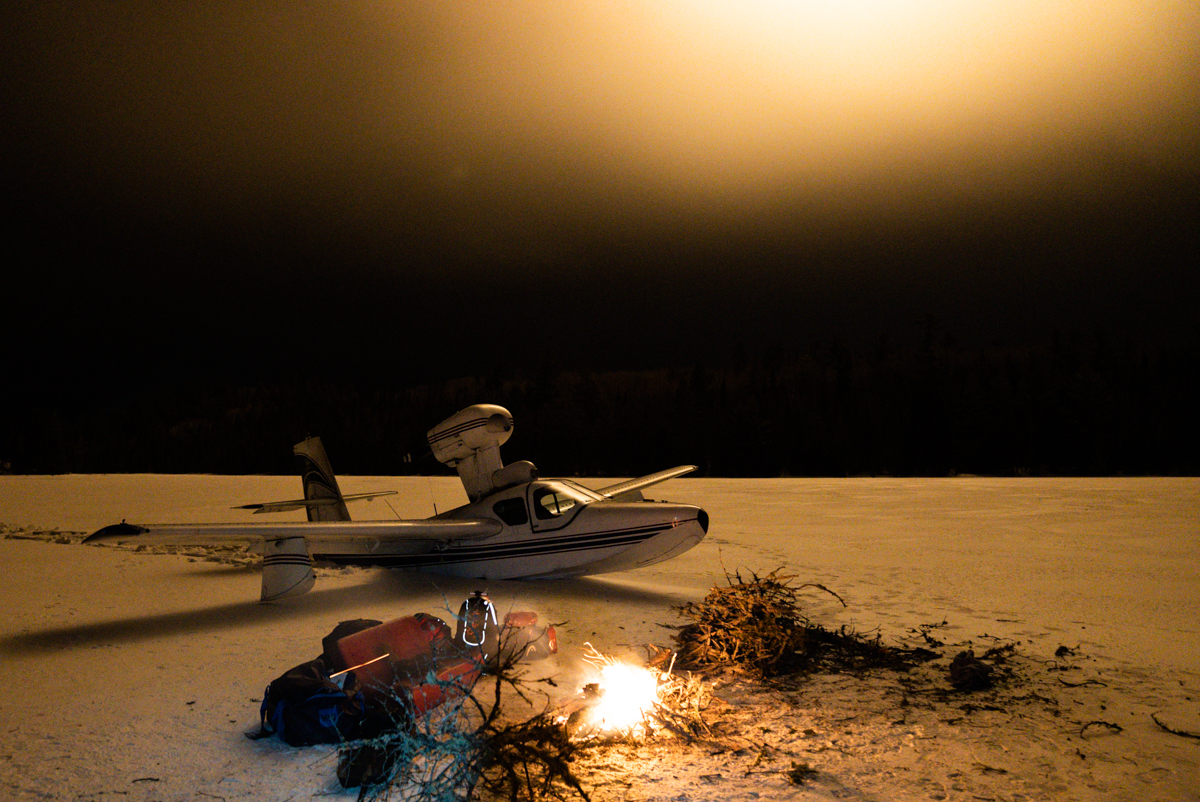
“They’re going to send jumpers,” Paul said. To which I replied “WTF?” By this time the cloud ceiling had dropped to 1700’ AGL, it was after dark and we could just barely make out the shadowy awesomeness of the Hercules circling above.
The Herc modified its holding pattern above, dropped a bunch more parachute flares to test the wind, and then we heard a “wooshing sound” as two green glow sticks with LED lights above came careening out of the sky attached to two very big, very brave SAR Techs. The pair glided in gracefully, landed on the ice nearby and rolled up into little balls with their HUGE packs, parachutes, lines and rigging everywhere. I later learned that they jump with so much weight in their first-responder packs that they don’t even attempt to land on their feet because they would probably break both legs if they did. We made our introductions on the ice and you could tell that the SAR Techs were surprised to find us 1) alive and unhurt and 2) chipper and offering them tea by a warm fire.
“When a small plane crashes in the north in the winter it NEVER turns out this way,” was something we heard a few times during our rescue.
The SAR Techs told us that, in case they couldn’t have made the jump due to the deteriorating weather, there was also a ground team attempting to get to our location overland. In every good rescue there is always a backup plan and usually backups for those plans also. It turns out that the Canadian Forces have an absolute minimum altitude of 1,500′ AGL for SAR rescue jumps and the ceiling over the lake when they arrived that night was 1,700′ AGL and falling. We were very lucky to be seeing them at all.
The revised plan was to spend the night enjoying a wilderness camping experience with the best the Canadian Forces had to offer, and that a helicopter would come and pick us all up in the morning. Great, I had been looking for an excuse to take Paul winter camping and this was even better than the best one I could have come up with. Paul loves spending time in the bush but has a fantastic camp that we enjoy together a lot but he had previously refused to ever sleep out in a tent in the winter. Never say never, Paul!
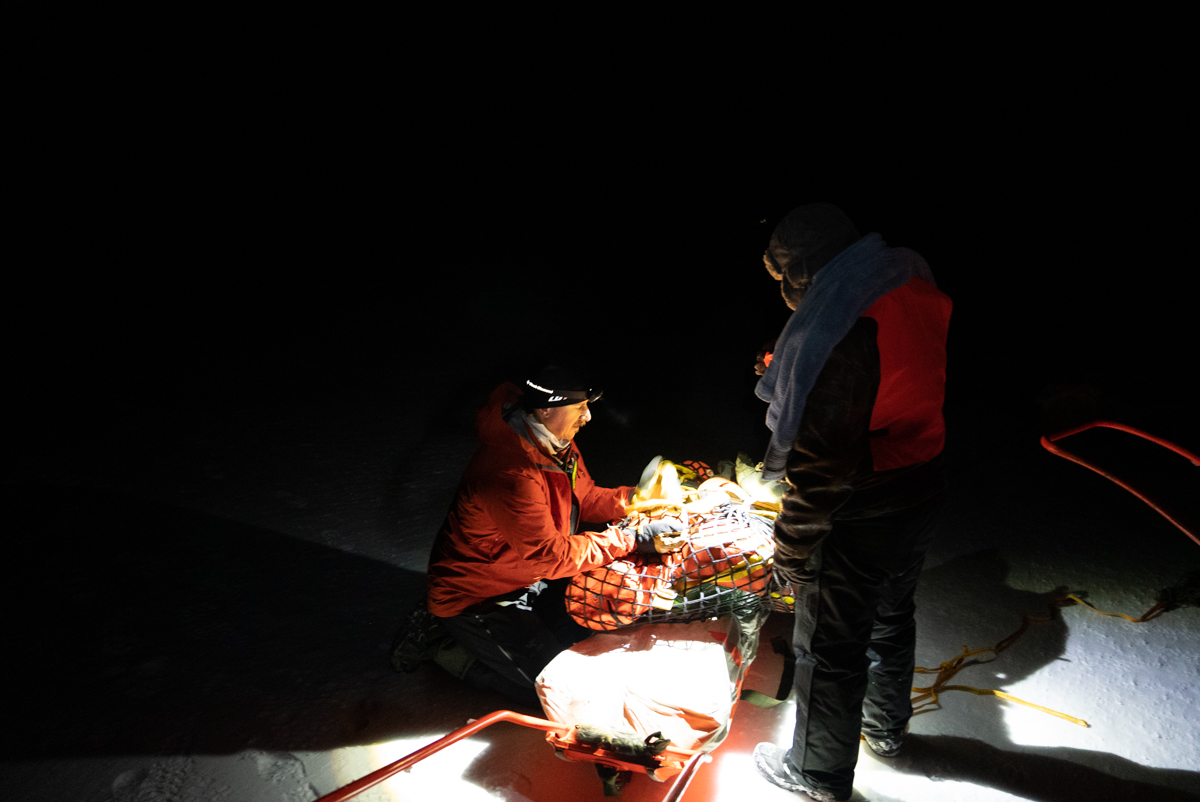
The SAR Techs called up to the Herc and ordered provisions for our impromptu winter camping experience. First out were the “rescue sleds,” two huge bright orange sleds strapped together with all manner of emergency equipment sandwiched in the middle. They contained everything from arctic-grade tents to extreme weather sleeping bags, Meals Ready to Eat (MREs), stoves, fuel, clothing and more first aid. Everything was very well organized in stuff sacs or vacuum sealed in clear plastic bags, and all very well labeled in case just the provisions and no SAR Techs could be deployed. This bundle of joy was strapped to strobe lights, a “chirper”, had its own parachute and landed not far off on the surface of the icy lake.
Next, the SAR Techs asked what else we needed and after a weak Starbucks joke I said that a better saw would be nice to harvest wood to keep the fire going. Next thing I knew, a huge box with chainsaws, axes, protective pants, a helmet, bar oil and all the accessories came floating in from the heavens. Amazing! I had to wonder what else they might have available up there but, unfortunately, it was time to say goodbye to our friends in the C-130 as it headed back to base in Trenton. We got started setting up for a night out on the ice in -20C. Paul and I had been prepared to camp out on our own if need be but it suddenly felt like we had now been upgraded to the “glamping package.”
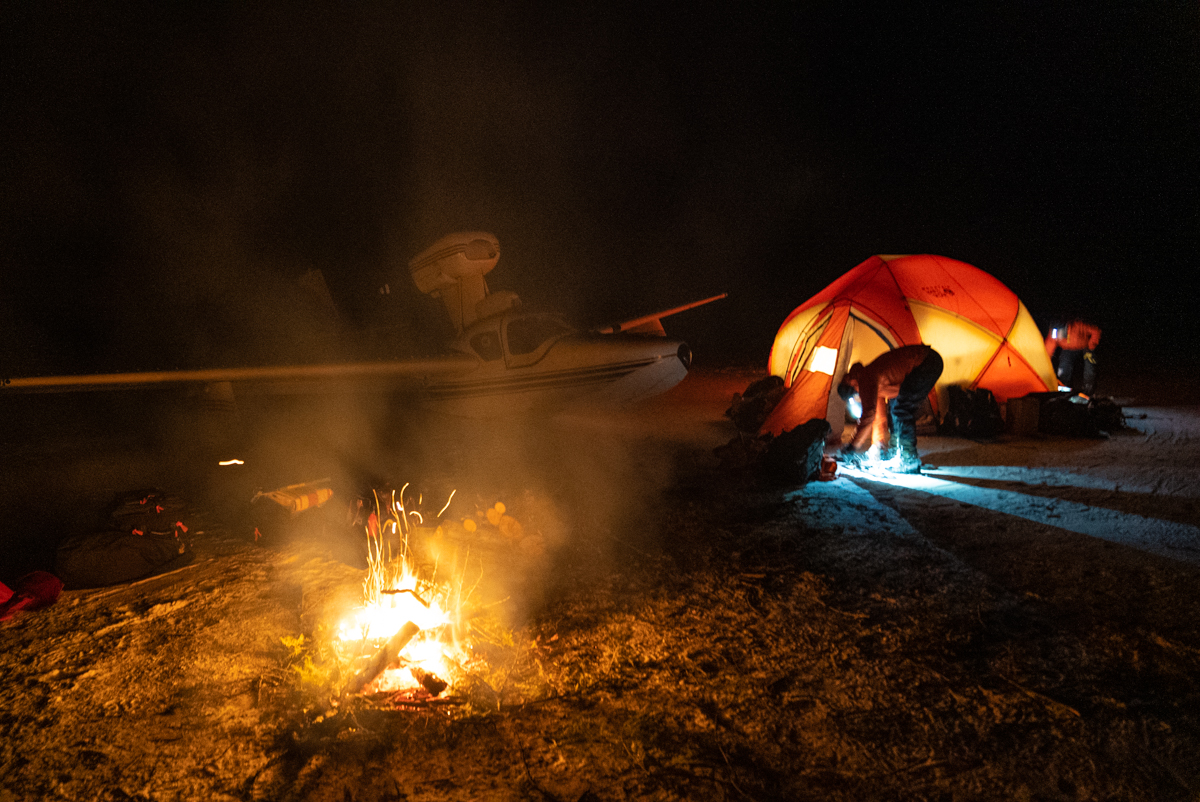
The SAR Techs performed their initial medical assessment on Paul and me and we got a clean bill of health. Once that detail was taken care of it basically became four guys working as a team setting up camp in the bush for a fun night out. A massive Mountain Hardware expedition-grade tent went up, with its twenty or so oversized poles. Wow, what a tent, expedition-grade for sure! The Coleman stove was lit inside for warmth and water was put on to boil for dinner. Next came the little details to make camp more comfortable. I looked over at one point to see Paul happily bucking up firewood with the chain saw to keep us warm all night. Sleeping bags were set out and we all chose our dinner from the abundant boxes of strangely satisfying and highly entertaining MREs. The SAR Techs strongly recommended against the hamburger MRE and even had the nickname, “hamburger pain” for that one, since they claimed that it “stopped you up for days”. Enough said… I settled for the Ravioli dinner as that sounded like a safe bet. Each MRE bag came with EVERYTHING you could wish for in order to get calories into your body quickly and efficiently in a rescue environment. There were hand wipes, cutlery, chocolate bars, tea, coffee, hot chocolate, electrolyte drinks, a weird drink bag/cup thingy for hot or cold liquids, peanut butter and jam in squeeze bags and strange freeze dried tortilla-like things that the SAR Techs strangely relished. Of course there was the main course which was different for each MRE selection and even a breath mint to stay fresh for your tent-mates afterwards. Very civilized!
With dinner done it was time for a little entertainment. One of the SAR Techs asked how our forced landing went, to which I said, “Do you want to see it?”. Just prior to departing on this mission with Paul I had decided to start my own YouTube channel all about my aviation adventures, so of course I had cameras rolling for most of our trip, including during our engine failure and forced landing on the lake. I tethered one of my INSTA360 action cams to my iPad right there in the tent and played the forced landing sequence from start to finish for the SAR Techs. After that I played the clip of them parachuting in and landing on the lake — which they loved!
After all the day’s excitement it was time for a little shut-eye so Paul and I crawled into our sleeping bags at this amazing little B&B that we had fortuitously stumbled upon and we hit the hay. I drifted into a snug sleep there on the ice, listening to the SAR Techs whisper quietly, the fire crackling outside, interspersed the odd giant cracking sound from the ice below. Cozy!
But it didn’t last. Around 2am we had a visitor to our little camp as a friendly Ontario Provincial Police officer strolled in on snowshoes. Now we once again had a link to the outside world. Word had spread that Paul and I were alive, healthy and perhaps even physically capable of walking out. For some unknown logistical reason a helicopter was not available for our planned morning extraction, so plan B had us following the OPP’s snowshoe track and walking out. I could see the SAR Techs cringe a little at the thought of the hike out as they had taken the call for our rescue just after their “leg day” workout at the gym in Trenton less than 12 hours earlier.
We broke camp and piled everything on the two rescue sleds, or safely in the plane on the ice for later extraction. Well before sunrise we set off over the ice following a GPS breadcrumb trail out to some OPP snow machines that we were told were “a couple of kilometers away as the crow flies”. Pushing the multiple-hundred pound, overloaded sleds on the flat lake surface was brutal. When we got to the shore and started overland through the bush it took about two steps to realize that the sleds and most of the gear would have to be left at the edge of the frozen lake. The snowshoe trail through the woods was not your average weekend nature trail but rather the quickest way to get between two GPS points, and this often meant going over logs, thick bush, deep snow and relatively unfriendly terrain. Luckily we had snowshoes provided by our OPP friend but the going was tough!
Eventually we made it to the three snow machines and two more OPP officers who rode us homeward down the worst tag alder-covered snowmobile trail I have ever been on. We were whipped and beaten by branches for five kilometers until we reached the tracked UTV that belonged to the awesome North Shore Search and Rescue Team. The two SAR Techs, Paul and I all piled into this crazy machine and travelled the rest of the 8km to vehicles waiting at the end of a logging road. Now there were baked goods, coffee and warm vehicles to relax in. Still no cell service but we were rapidly getting closer to “civilization”. Soon we were bumping down the road and back towards the real world.
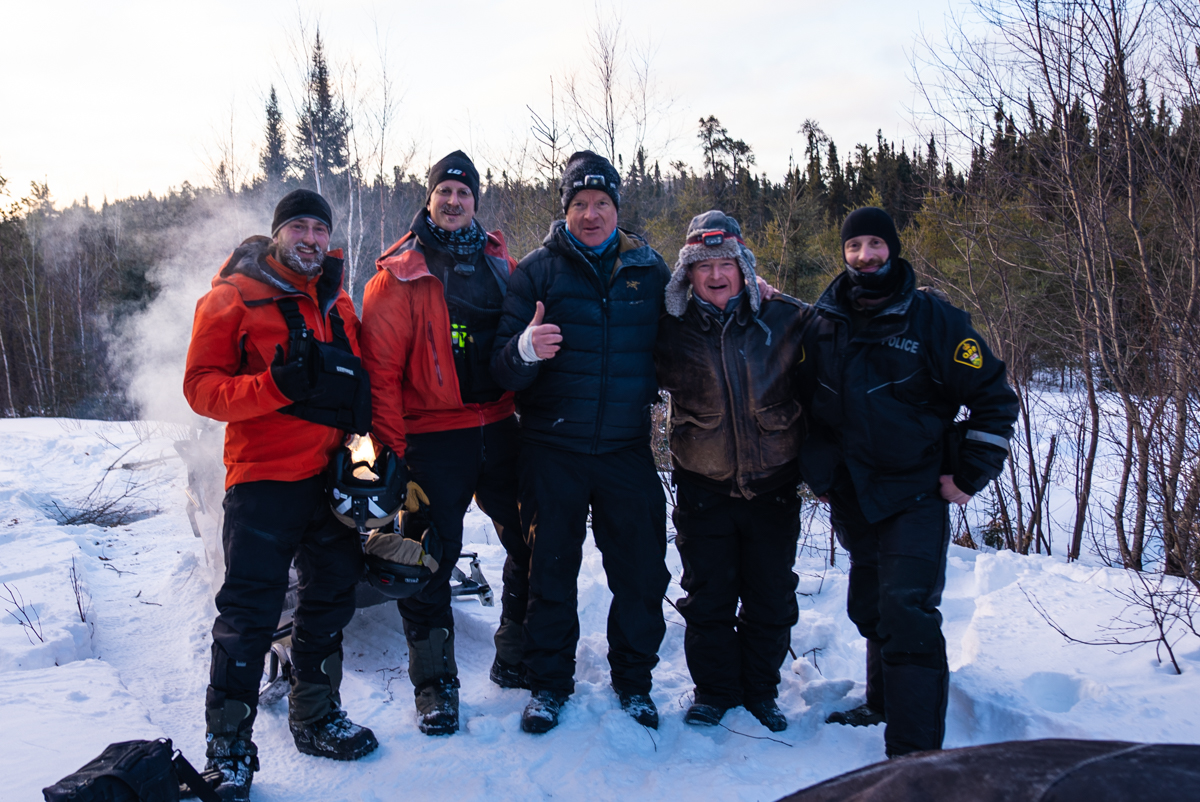
Once we entered cell service my phone blew up with voicemails, texts and calls from loved ones who wanted to know I was OK which, I have to admit, made me a little emotional. At no point during the experience was I at all panicked, in pain, overly uncomfortable or scared, but I hated the fact that I had no way to contact friends and family from our remote location and it saddened me that I had caused them stress. Immediately upon returning home both Paul and I invested in two-way global satellite messaging units
It was a strange sensation coming back to the real world. Our entire rescue scenario took place over a span of less than 24 hours but that experience came on the back of a week’s hard flying. It wasn’t until I was sitting in the warm cab of a rescuer’s idling 4X4 drinking hot coffee and munching on a tasty muffin that I realized how cold and weary my bones were and how tired I really was. Thankfully one of the team at North Shore Search And Rescue was heading south and could get Paul and I back to our vehicles that we had left at the Muskoka airport a week and a million miles earlier. Once there, I said good bye to my amazing friend and adventure companion and headed home.
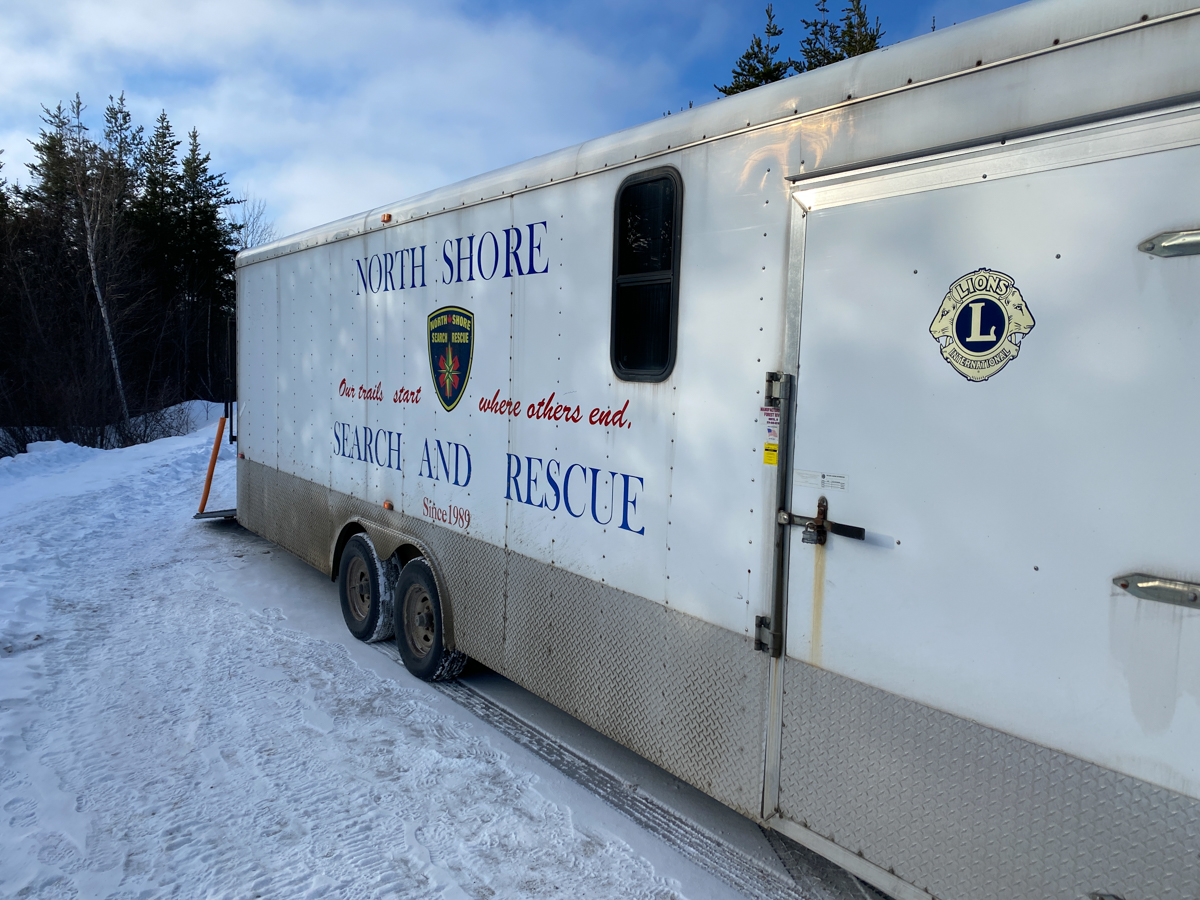
Now it’s summer, and sitting here in the comfort of my office writing this I still get a bit emotional. I’m grateful to all the people and entities that provided assistance to Paul and me in our time of need. Here’s to the Canadian Forces with their exceptionally capable and brave SAR Techs who led the rescue; to the Ontario Provincial Police as well as North Shore Search And Rescue for local support and their boots-on-the-ground capabilities; to all the amazing people at NAV Canada who followed our every move across the country and back again, eventually pinpointing our precise location down on the ice. And of course to our friends and families who love and support us and put up with our adventures in aviation and to everyone who came to our aid when we needed it most. I offer heartfelt thanks to you all.
I am starting a YouTube channel that covers my adventures in aviation, both in flying manned aircraft and in my professional work with drones. This story is told in Episode #1 – Lake Rescue and is available HERE. Please like and subscribe to the channel as I plan to continue to post my aviation fun and adventures — although I hope future episodes are perhaps a tiny bit less dramatic.
Fly safe and enjoy!
Tom Comet
